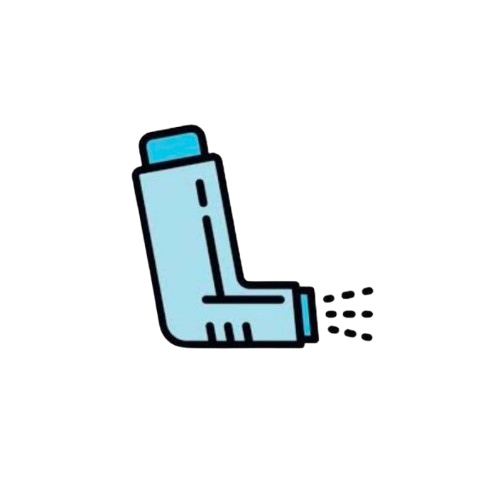Revefenacin
Allopathic
Medicines List
All MedicineIndications
Approved Indications:
- Maintenance treatment of chronic obstructive pulmonary disease (COPD):
- Indicated for the long-term, once-daily maintenance treatment of airflow obstruction in patients with COPD, including chronic bronchitis and emphysema.
- Not indicated for acute bronchospasm or asthma.
Off-label / Clinically Accepted Uses:
- May be considered for patients with COPD who have difficulty using handheld inhalers or require nebulized therapy.
- Use in COPD patients with moderate to severe airflow limitation who benefit from LAMA therapy.
Dosage & Administration
Adults:
- Recommended dose: 175 mcg (1 vial) inhaled once daily via a standard jet nebulizer.
- Administer as a nebulized solution with a mouthpiece or facemask.
Pediatrics:
- Safety and efficacy not established; not recommended.
Elderly:
- No dosage adjustment necessary; use standard adult dose.
Renal Impairment:
- No dosage adjustment needed for mild to moderate impairment.
- Use with caution in severe impairment due to lack of data.
Hepatic Impairment:
- No dosage adjustment recommended for mild or moderate impairment.
- Use caution in severe hepatic impairment; insufficient data.
Administration Notes:
- Use once daily at approximately the same time each day.
- Do not use more than one vial per day.
- Rinse mouth after use to reduce risk of oral candidiasis.
Mechanism of Action (MOA)
Revefenacin is a long-acting muscarinic antagonist (LAMA) that selectively blocks M3 muscarinic receptors on airway smooth muscle. By competitively inhibiting these receptors, it prevents acetylcholine-induced bronchoconstriction, leading to bronchodilation and improved airflow in the lungs. Its prolonged receptor binding provides sustained bronchodilatory effects suitable for once-daily dosing in COPD maintenance therapy.
Pharmacokinetics
- Absorption:
- Systemic absorption after nebulized administration is low to moderate.
- Peak plasma concentrations occur approximately approximately 6 to 9 minutes post-dose.
- Distribution:
- High plasma protein binding (~71%).
- Volume of distribution not extensively reported.
- Metabolism:
- Primarily metabolized by hydrolysis to an active metabolite (THRX-195518), which has ~10-fold lower potency than parent drug.
- Minor CYP450 involvement.
- Elimination:
- Eliminated mainly via feces (biliary excretion) and urine.
- Parent drug has a terminal half-life of approximately 22 to 70 hours.
- Active metabolite has a longer half-life (~50 hours).
Pregnancy Category & Lactation
Pregnancy:
- No adequate, well-controlled studies in pregnant women.
- Animal studies have not shown direct teratogenic effects at clinically relevant exposures.
- Use only if potential benefits outweigh risks.
Lactation:
- Unknown if inhaled revefenacin is excreted in human milk.
- Caution advised when administered to breastfeeding women; monitor infant for adverse effects.
Therapeutic Class
- Primary Class: Bronchodilator
- Subclass: Long-acting muscarinic antagonist (LAMA), anticholinergic bronchodilator
Contraindications
- Known hypersensitivity to revefenacin or any of its excipients
- Hypersensitivity to other anticholinergic agents (caution)
- Not indicated for acute bronchospasm or asthma treatment
Warnings & Precautions
- Paradoxical bronchospasm:
- Discontinue immediately if it occurs.
- Narrow-angle glaucoma:
- Use with caution as anticholinergics may increase intraocular pressure.
- Urinary retention:
- Use cautiously in patients with urinary retention or prostatic hypertrophy.
- Cardiovascular effects:
- Monitor patients with cardiovascular disease as anticholinergic drugs may cause tachycardia.
- Hypersensitivity reactions:
- Rare but may include rash, urticaria, angioedema.
Side Effects
Common Adverse Effects:
- Cough
- Nasopharyngitis
- Headache
- Upper respiratory tract infection
- Back pain
Less Common/Rare:
- Paradoxical bronchospasm
- Hypersensitivity reactions
- Urinary retention
- Increased intraocular pressure or glaucoma symptoms
Timing:
- Side effects usually occur within the first weeks of therapy; ongoing monitoring recommended.
Drug Interactions
- Minimal CYP450 metabolism reduces potential for significant interactions.
- Caution when used concomitantly with other anticholinergic drugs (additive anticholinergic effects).
- No significant drug-food or drug-alcohol interactions reported.
Recent Updates or Guidelines
- GOLD 2024 guidelines recommend LAMA agents including nebulized options like revefenacin for maintenance therapy in COPD patients with moderate to severe disease, especially those with difficulty using handheld inhalers.
- No new major safety warnings or dosing changes reported in the past 2 years by FDA or EMA.
- Ongoing monitoring recommended for long-term safety.
Storage Conditions
- Store at 20°C to 25°C (68°F to 77°F)
- Protect from freezing and excessive moisture
- Keep vial in original packaging until use
- Use immediately after opening vial; discard any unused portion
